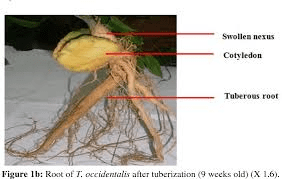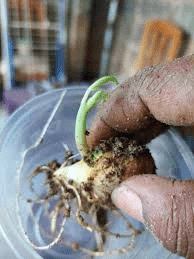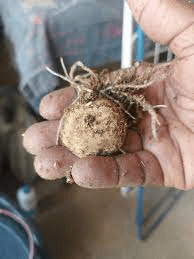The fluted pumpkin (Telfairia occidentalis), a vital vining plant native to West Africa, is renowned for its edible leaves and nutritious seeds. However, beneath the soil lies a hidden network crucial for the plant’s survival and success – the root system. While often overlooked, fluted pumpkin roots exhibit a fascinating scientific design with specific anatomical features and physiological functions.
Fluted pumpkin roots are classified as taproots. Unlike fibrous root systems, taproots consist of a dominant primary root that extends deep into the soil. This primary root gives rise to lateral roots that branch out horizontally at various depths.
The taproot structure allows the fluted pumpkin to access water and nutrients from deeper soil layers, particularly during dry periods when surface moisture becomes scarce. Internally, the fluted pumpkin root exhibits a similar structure to other dicotyledonous plants.
The central portion, called the stele, contains the vascular tissues responsible for transporting water and solutes throughout the plant. The xylem, located towards the center of the stele, is responsible for transporting water and dissolved minerals upwards from the soil to the leaves.
Phloem, situated closer to the outer portion of the stele, transports the products of photosynthesis, primarily sugars, from the leaves down to the growing parts of the plant and storage organs like the seeds. Surrounding the stele is the cortex, a layer of parenchyma cells.
These cells provide structural support, store carbohydrates for energy reserves, and might also play a role in nutrient storage and root respiration.
The outermost layer of the fluted pumpkin root is the epidermis, a single layer of cells responsible for initial water and nutrient uptake from the soil. Root hairs, microscopic extensions of epidermal cells, increase the surface area for efficient water and nutrient absorption.
The fluted pumpkin root system plays a critical role in the plant’s overall health and growth. The primary function of the roots is water and nutrient acquisition.
The deep taproot structure allows the plant to access water reserves in deeper soil layers, particularly during dry seasons or in areas with limited rainfall. Additionally, root hairs significantly increase the surface area for efficient water and nutrient absorption from the soil solution.
The vascular tissues within the root then transport these absorbed materials throughout the plant, providing the necessary resources for photosynthesis, growth, and reproduction. Beyond water and nutrient uptake, the roots also play a role in anchoring the plant in the soil, especially crucial for a climbing vine like the fluted pumpkin.
The extensive root network provides stability and prevents the plant from being uprooted by strong winds or heavy rains. Furthermore, fluted pumpkin roots might possess interactions with beneficial soil microbes.
These microbes can assist with nutrient acquisition by solubilizing otherwise unavailable minerals in the soil or by fixing atmospheric nitrogen, making it usable by the plant.
Research suggests that the roots might also play a role in the plant’s defense mechanisms. Certain root exudates might have antimicrobial properties, deterring harmful soilborne pathogens or attracting beneficial organisms that can suppress these pathogens.
The morphology and physiology of fluted pumpkin roots can exhibit some variation depending on growing conditions. Plants grown in drier environments with limited rainfall are likely to develop deeper taproots to access water reserves in lower soil layers. Conversely, plants grown in moist environments might have shallower root systems.
Additionally, soil characteristics like texture and nutrient availability can influence root development. More compacted soils might necessitate the development of stronger and more extensive root systems for effective penetration and nutrient acquisition.
The scientific exploration of fluted pumpkin roots reveals a complex and well-adapted system. From the deep taproot structure to the specialized tissues for water and nutrient uptake, these hidden structures play a vital role in the plant’s survival and success.
Understanding the anatomy and function of fluted pumpkin roots can provide valuable insights for optimizing cultivation practices, particularly in areas with water scarcity or challenging soil conditions. Further research into the interactions between fluted pumpkin roots and soil microbes can inform the development of sustainable agricultural practices that promote plant health and soil fertility.
The Economic Importance and Uses of Fluted Pumpkin Roots

While the fluted pumpkin (Telfairia occidentalis) is primarily cultivated for its leaves and seeds, its hidden root system offers surprising economic importance and potential uses. Often overlooked, fluted pumpkin roots possess unique characteristics and functionalities that contribute to the plant’s overall value. Here’s a closer look at the economic benefits and diverse applications of these underground structures:
1. Enhanced Drought Tolerance: Fluted pumpkin roots, with their deep taproot structure, enable the plant to access water reserves in deeper soil layers. This is particularly beneficial during dry seasons or in areas with limited rainfall. By accessing this vital resource, fluted pumpkin can maintain growth and productivity even under challenging water scarcity conditions.
2. Improved Nutrient Uptake: The extensive root network of fluted pumpkin, with its fine root hairs, significantly increases the surface area for efficient nutrient absorption from the soil solution. This allows the plant to take up essential minerals like phosphorus, potassium, and nitrogen, crucial for growth, development, and seed production.
3. Potential for Biofertilizer Production: Research suggests that fluted pumpkin root exudates might harbor beneficial rhizosphere bacteria. These bacteria can play a vital role in plant growth by solubilizing otherwise unavailable minerals in the soil, making them accessible for plant uptake. Further research on these root-associated microbes could lead to the development of biofertilizers that promote plant health and reduce reliance on chemical fertilizers.
4. Potential for Biopesticide Development: Fluted pumpkin roots might produce secondary metabolites with antimicrobial properties. These compounds could potentially deter harmful soilborne pathogens or nematodes that threaten plant health. Extracting and isolating these root-derived compounds could pave the way for the development of natural biopesticides, promoting a more sustainable approach to pest management.
5. Potential for Medicinal Applications: Early studies suggest the presence of bioactive compounds in fluted pumpkin roots. These compounds might possess antioxidant, anti-inflammatory, or other health-promoting properties. Further research is needed to explore the potential medicinal applications of these root extracts. If proven beneficial, they could be incorporated into herbal remedies or functional food products.
6. Soil Stabilization and Erosion Control: The extensive network of fluted pumpkin roots helps anchor the plant in the soil, particularly crucial for a climbing vine. This root network also contributes to soil stabilization, preventing erosion caused by wind or heavy rainfall. In areas susceptible to soil erosion, fluted pumpkin cultivation can be a valuable tool for sustainable land management practices.
7. Potential for Phytoremediation: Phytoremediation is the use of plants to remove contaminants from soil or water. Fluted pumpkin roots, with their ability to absorb and accumulate certain heavy metals, might hold potential for phytoremediation applications. Research is needed to determine the effectiveness of fluted pumpkin in removing specific contaminants and developing strategies for safe and sustainable phytoremediation practices.
8. Potential for Biofuel Production: While fluted pumpkin roots might not be the primary source of biomass for biofuel production, they could potentially contribute to a biorefinery approach. The starchy reserves present in the roots could be converted into biofuels like ethanol through fermentation processes. However, further research is needed to determine the economic feasibility and efficiency of biofuel production from fluted pumpkin roots compared to other plant materials.
Read Also: How to Use Rice Husk to Produce Electricity
The Products and By-products That Can Be Derived From Fluted Pumpkin Roots

1. Biofertilizers with Beneficial Microbes: The rhizosphere bacteria associated with fluted pumpkin roots, as mentioned earlier, could be harnessed for biofertilizer production. These bacteria can be isolated, multiplied, and formulated into biofertilizers. When applied to soil, they can promote plant growth by enhancing nutrient availability and potentially improving plant defense mechanisms. Biofertilizers derived from fluted pumpkin root-associated microbes offer a sustainable and eco-friendly alternative to chemical fertilizers.
2. Biopesticides from Root-derived Antimicrobial Compounds: Research on the isolation and purification of antimicrobial compounds from fluted pumpkin roots could lead to the development of biopesticides. These natural biopesticides could be formulated as sprays or soil amendments to target specific soilborne pathogens or nematodes without harming beneficial soil organisms. Developing biopesticides from fluted pumpkin roots aligns with the growing demand for sustainable and eco-friendly pest management practices.
3. Medicinal Extracts with Potential Health Benefits: If further research confirms the presence and functionality of bioactive compounds in fluted pumpkin roots, these compounds could be extracted and processed into medicinal products. Depending on their properties, they might be used in herbal remedies, nutraceuticals, or functional food ingredients. For example, if the extracts exhibit anti-inflammatory properties, they could be incorporated into products for managing inflammatory conditions.
4. Food Additives with Functional Properties: Similar to medicinal extracts, functional food additives might be derived from fluted pumpkin roots. These additives could potentially enhance the nutritional value of food products or offer additional health benefits. For instance, if the root extracts possess antioxidant properties, they could be used as natural food preservatives or added to food products to promote overall health. Further research is crucial to determine the safety and efficacy of these root-derived food additives.
5. Soil Amendment for Improved Soil Structure: Fluted pumpkin roots, after harvest or processing, could be transformed into a soil amendment. The organic matter content of the roots can help improve soil structure, aeration, and water retention capacity. This can benefit various crops by creating a more favorable environment for root growth and nutrient uptake. Additionally, the presence of beneficial microbes associated with the roots might contribute to improved soil health and overall plant growth.
6. Potential for Biochar Production with Carbon Sequestration Benefits: Biochar, a charcoal-like substance, can be produced from fluted pumpkin roots through pyrolysis (heating in the absence of oxygen). Biochar application to soil offers several advantages. It can improve soil fertility, increase water retention, and potentially sequester atmospheric carbon dioxide. Fluted pumpkin root-derived biochar could be a valuable tool for sustainable soil management practices and climate change mitigation efforts.
7. Production of Traditional Medicines in Local Communities: In some West African communities with a history of using fluted pumpkin for various purposes, traditional medicine practices might utilize the roots. Decoctions or poultices prepared from fluted pumpkin roots might be used for treating specific ailments. Further research is needed to document these traditional practices, understand their potential effectiveness, and ensure safe use.
8. Potential for Developing Industrial Products: While research is still ongoing, the potential exists for utilizing fluted pumpkin roots in industrial applications. The cellulose content in the roots might be explored for the production of bioplastics, offering a biodegradable alternative to petroleum-based plastics. Additionally, the fibrous nature of the roots could be investigated for use in composite materials or as a source of natural fibers for various industrial applications.
9. Potential for Arts and Crafts: Although not as common as using the vines, fluted pumpkin roots with unique shapes or textures might be employed in arts and crafts. After proper cleaning and drying, the roots could be incorporated into sculptures, wall hangings, or other decorative items. This application adds value to the roots and promotes traditional craft practices.
10. Research on Animal Feed Applications: Research is needed to explore the potential of fluted pumpkin roots as a source of animal feed. The presence of carbohydrates and other nutrients in the roots might make them suitable for incorporation into animal feed formulations, particularly for ruminant animals with complex digestive systems capable of utilizing cellulose.
11. Vermicompost for Organic Farming with Additional Benefits: While fluted pumpkin vines are more commonly used for vermicomposting, the roots could potentially be composted using earthworms as well. The resulting vermicompost can be a valuable organic soil amendment for use in organic farming practices. Beyond its nutrient content, vermicompost derived from fluted pumpkin roots might possess additional benefits due to the presence of beneficial microbes associated with the roots.
Read Also: 5 Medicinal Health Benefits Of Meriandra dianthera (Mint Marjoram)
Frequently Asked Questions (FAQ’s) About Fluted Pumpkin Roots

1. Are fluted pumpkin roots edible?
There is limited information on the edibility of fluted pumpkin roots. While some sources suggest they might be consumed after proper preparation, others advise against it due to potentially bitter taste or the presence of unknown compounds. Further research is needed to determine the safety and potential nutritional value of fluted pumpkin roots for human consumption.
2. How deep do fluted pumpkin roots typically grow?
The depth of fluted pumpkin roots can vary depending on growing conditions. In areas with limited rainfall, the roots can grow quite deep, potentially reaching several meters to access water reserves in lower soil layers. Conversely, in areas with consistent moisture, the root system might be shallower and more widespread.
3. What factors can influence the growth and development of fluted pumpkin roots?
Several factors can influence fluted pumpkin root growth and development. Soil moisture availability plays a crucial role. Drier conditions will encourage deeper root growth, while adequate moisture might lead to a shallower and more extensive root system. Soil characteristics like texture and nutrient content can also influence root development. More compacted soils might necessitate the development of stronger and more extensive root systems for effective penetration and nutrient acquisition.
4. Can fluted pumpkin roots be used in intercropping systems?
Fluted pumpkin, with its deep taproot system, can be a suitable companion plant in intercropping systems. The deep roots of fluted pumpkin can access water and nutrients from deeper soil layers, minimizing competition with shallower-rooted companion plants for these resources. However, the specific companion plant selection and planting arrangements need careful consideration to ensure compatibility and optimal growth for both crops.
5. What are the potential challenges associated with utilizing fluted pumpkin roots?
One challenge associated with utilizing fluted pumpkin roots is the relatively low biomass compared to the above-ground parts of the plant. Harvesting a significant amount of roots for various applications might require careful planning and potentially impact overall plant growth and productivity. Additionally, research on the effectiveness and safety of some potential applications, like using the roots for medicinal purposes or animal feed, is still in its early stages.
6. How can the harvesting of fluted pumpkin roots be optimized for sustainable use?
Sustainable harvesting practices are crucial when utilizing fluted pumpkin roots. Selective harvesting of mature roots, leaving a portion of the root system intact, can minimize impact on plant health and ensure continued growth. Additionally, exploring techniques like co-cropping with deep-rooted companion plants can help maintain soil health and nutrient cycling even with some root removal.
7. What research is ongoing related to fluted pumpkin roots?
Research on fluted pumpkin roots is expanding. Scientists are investigating the potential of root-associated microbes for biofertilizer development, the isolation and characterization of bioactive compounds for medicinal applications, and the feasibility of using the roots for biofuel production or biochar generation.
8. Where can I find more information about fluted pumpkin roots?
Information on fluted pumpkin roots is becoming increasingly available online through research articles and agricultural extension resources. Universities and research institutions in West Africa, where fluted pumpkin is a major crop, might offer valuable insights and ongoing research projects on this underutilized plant part. Additionally, organizations promoting sustainable agriculture practices might provide information on the potential of fluted pumpkin roots in various applications.
9. How can I get involved in utilizing fluted pumpkin roots?
Farmers interested in exploring the potential of fluted pumpkin roots can connect with agricultural extension services or research institutions to learn about sustainable harvesting practices and potential applications. Businesses can investigate the feasibility of incorporating fluted pumpkin roots into their products or processes, aligning with sustainable and eco-friendly practices. Consumers can support products or agricultural practices that utilize fluted pumpkin roots responsibly, promoting a more circular bioeconomy.
10. What does the future hold for fluted pumpkin roots?
With ongoing research and development, fluted pumpkin roots have the potential to become a valuable and sustainable resource. Their applications in biofertilizers, biopesticides, biochar production, and potentially even as a source of industrial materials can contribute to a more sustainable agricultural system and a circular bioeconomy. By unlocking the hidden potential of this often-overlooked plant part, we can create a future where fluted pumpkin offers even greater economic and environmental benefits.
Read Also: Understanding the Basics of Environmental Law





